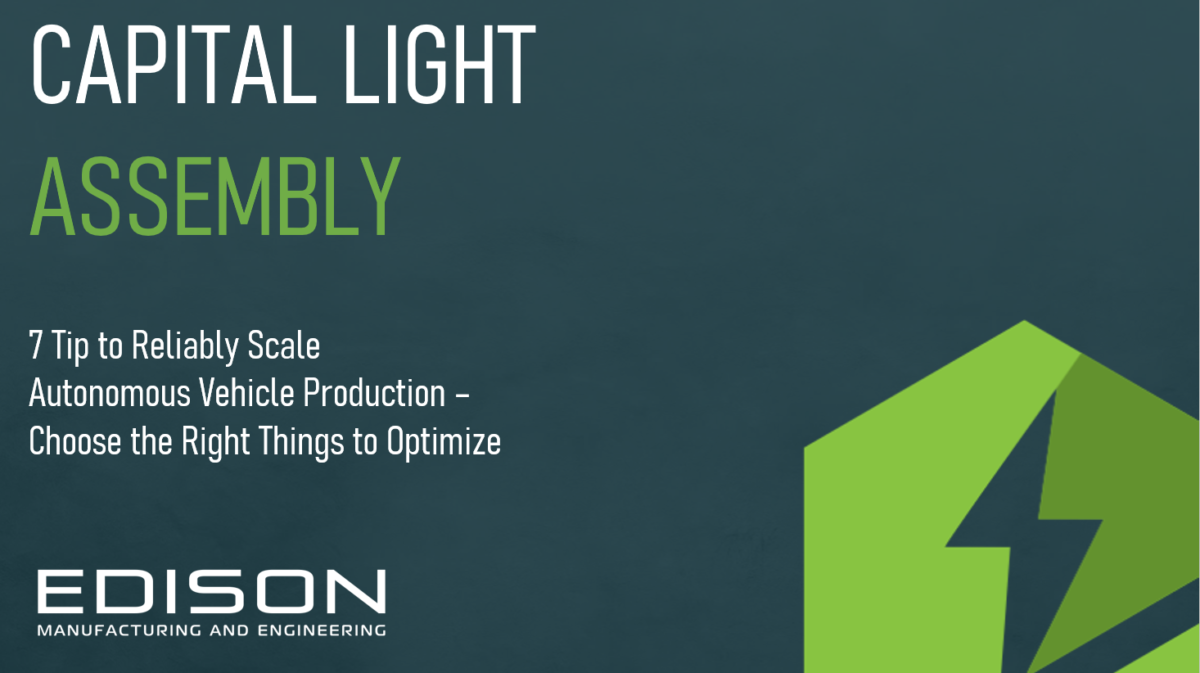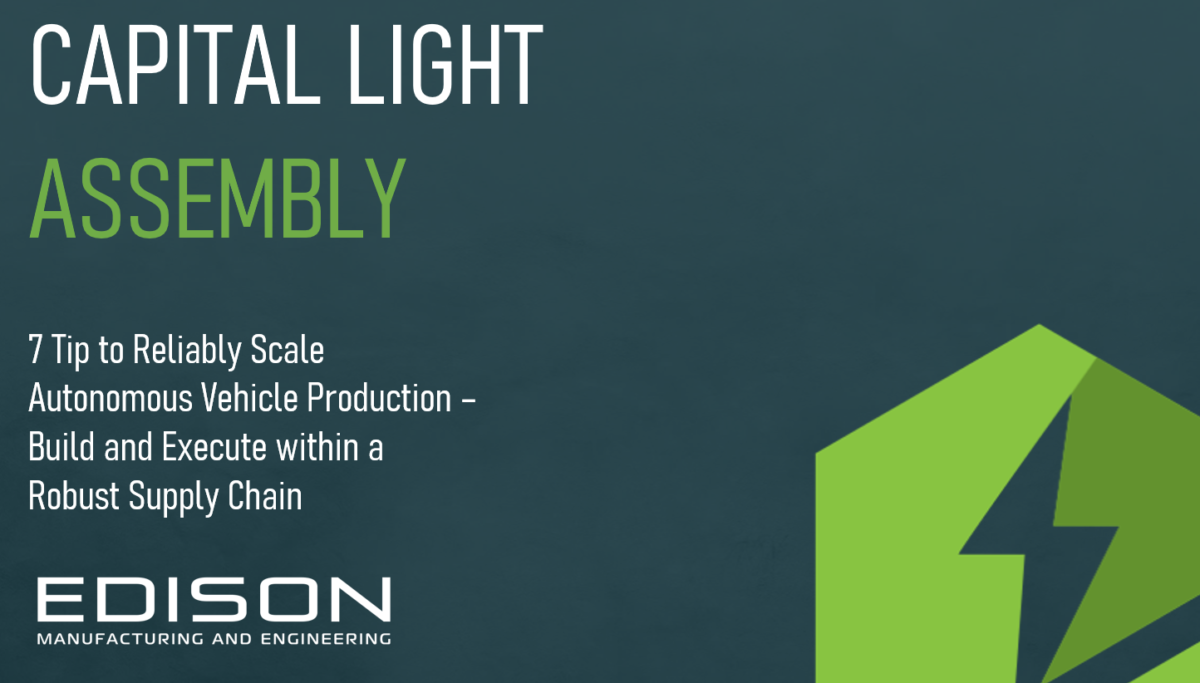In this discussion, the Capital Light Assembly podcast welcomes Nic England, who used to work as director of supply chain and operations at Edison. Nic shares with Brandon, the host, insights on the importance of effective supply chain management and project execution. He highlights how these strategies contribute to the delivery of high-quality products at Edison. This is an informative session for anyone interested in learning more about successful supply chain management practices and their impact on product quality.
Key Takeaways
- The suppliers you work with affect how well-prepared, accurate, and efficient your operations are. To ensure you have high quality in your organization, you need to have a solid strategy and execution plan.
- Edison can strategize quality very early in the production process, ensuring that manufacturers have an enhanced sense of quality from the get-go.
- Edison's approach is to first prioritize the people and processes involved in production, rather than relying heavily on automation from the beginning. This approach aims to achieve OEM-level quality while maintaining a hands-on, capital-light approach.
Transcript:
Brandon: Welcome to the Capital Light Assembly podcast brought to you by Edison Manufacturing and Engineering. Edison is your low-volume contract manufacturing partner for capital-light assembly of complex mobility and energy products that don’t neatly fit within traditional high-volume production. I’m Brandon Bartneck, head of business development, and I’m joined here today by Nic England, who leads our operations and supply chain activities. Nic, thanks for joining.
Nic: Yeah, Brandon, thanks for having me. As Brandon said, I work for Edison, and I’m in charge of the operations and supply chain here.
Brandon: Awesome, yeah, so the topic is here. So, in the first episode, we talked about quality with Frank, who leads our engineering and program management. I think it’d be interesting to get your perspective from the supply chain and operations perspective on what quality looks like, so maybe let’s start on the supply chain side. So, for the type of builds that Edison executes – low volume, capital-light, complex assembly – what are the key considerations for quality from a supply chain perspective?
Nic: So when you’re talking about the type of builds that we focus on, initially, they’re going to be very, very low volumes. You know, overall, our strategy is for low-volume, highly complex assemblies, so initially, we’re going to get into those low-volume builds from an engineering standpoint and really be able to understand what the requirement is from a customer standpoint. I think that’s, first and foremost, the main point of how we assess quality. On the back end, you obviously have to have the correct inputs, so really working with our customer base and understanding what their requirements are initially up front is obviously key, as would be with any industry or manufacturing process. But where we take over, where we excel from an Edison standpoint, is that we have the ability for us to be more intimate with that design up front. We are a partner that comes in very early on in the engineering phase, which allows us to focus not only on the quality of the off-the-shelf parts and the parts that may have been sourced already by the customer or parts that we need to source from more of standard off the shelf standpoint. It allows us to work with the customer on those manufactured parts or those specialty items that maybe you know can’t find off the shelf, they have long lead times, those are the items where we see the most opportunity from a quality standpoint, and it allows us to work very intimately with that customer right from the get-go. So, it allows us to make sure that we know what the quality standards are, and we can set those expectations with our supply base. One of the things that Edison has the ability to do is manage the supply chain, so when customers find out that we have the capability to focus on quality to that degree, it also frees them up a little bit if they choose to move some of their supply chains to Edison. It allows us to get more in tune with their quality standards prior to even outputting one single unit of whatever that product or whatever that component may be for that specific customer. So I think the ability for us to do that up front and not wait allows us to really hone in on what the expectations are, and then that in of itself is naturally going to create a product that is of higher quality and a higher standard because you’re putting those expectations and those requirements in right from the very beginning. One of the opportunities that companies have when they work with us is that level of detail right away. Those low-volume builds and those complex assemblies that we choose to partner with these organizations for – allow us to get in there, get dirty, and really understand what the requirement is. Not only that, but it allows us to make those recommendations – that’s what our engineering team is there for – to ensure that not only are we purchasing good components, are we receiving good components, but we are designing good components, are we designing components that are built to last and have that quality OEM standard.
Brandon: Great! Yeah, I think that’s a good place to start. I guess, just one note to point out, so we mentioned low volume assembly is kind of that – that’s what Edison does, and Nic, you’re starting to hear that the low, the even lower value engineering – so, when we’re talking low volume, we’re talking hundreds, thousands often, of units. But early on, it starts, as you mentioned here, with these engineering builds, which could be one, two, a handful, a dozen, or something like that. And yeah, the importance of defining the quality perspective up front. So I’m glad you highlighted that, and I guess one more follow-up question: So when we’re talking, yes, it’s really important to align up front with our partners and collaborators when we’re working. Can you give a brief thought on okay? There’s an aspect of inbound quality, right? We need to understand that the parts coming in are good and that they meet the requirements that have been defined. Can you talk about how we do that? Is it one size fits all, or how do we think about doing that for the different types of components that we are dealing with?
Nic: Yeah, there’s definitely not a one-size-fits-all. Especially with the organizations that we choose to work with, being able to have a very, very defined, inbound receipt process and a quality inspection process is obviously the next step. Once you pass that engineering phase and you start having higher volumes in the facility, or wherever you’re choosing to manufacture that product, that is absolutely critical to the operation's success. So from an inbound quality standpoint, you know we choose, like I said, to work from the engineering phase with customers very early on so that we can set those standards. So not only are we harnessing the 100% inspection of all inbound materials, we’re also harnessing the opportunity for working with engineering to ensure that those specifications are set up in our ERP system to ensure that on inbound receipt, we have the ability to assess whether a product that’s been shipped from a supplier or a fabricator or a manufacturer, whoever we’re choosing to get that part from, there are standards set in place. So as soon as that product hits the door, we have a game plan, and we have an understanding of what the requirements are, and that’s going to be on every single part that we receive. Whether that’s off the shelf or manufactured, those inspection processes are going to look very different – but again, they follow the same criteria, and we do that for specific reasons. We know that executing on whether it’s one build or a hundred for these customers is just as important as the next. So understanding that process and then building that process into our culture and our people is the next step. So making sure that our people on the floor and people that are our employees are really taking part in the receiving operation understand our mission and how we are able to achieve it.
Brandon: Yeah, we could talk for a long time about supplier and inbound quality and such. I think that’s a great kind of teaser here for this bite-sized format that we’re doing with this capital-light assembly podcast, and with that in mind, I think there is just one final question on this topic. For sure, we’re just going to scratch the surface here, maybe we’ll be able to do a deep dive sometime in the future, but talking about from an operational execution perspective – what, specifically, for the type of builds that we do first, low volume, capital light, complex assembly, what are the key points or the differentiators or the main things that are important from an operational execution perspective when talking about the quality of the end product?
Nic: Yeah, so again, this is another thing that I love to focus on because when you look at a manufacturing process, large manufacturers have a lot of automation. They’ve got a lot of predefined processes that are built into that manufacturing process. But one thing that we focus on, I think I’ve mentioned already, that we focus on upfront is our people. And we have the ability to do that. We have the ability to put more hands on the floor and more interaction with our product and our quality because we choose to operate in a very, very low-cost, capital-light environment. This allows us to put more focus from a people standpoint, so you know, when you look at your question, overall based on quality, there are a couple of things when I think of supply chain and operations and how they impact quality; you know your supply base translates to preparedness, accuracy, and efficiency or operation. Proper strategy and execution are going to support the level of quality that you inject into your organization. Ultimately, the level that you desire. So, that gets us to have that quality coming in the door, but then the next step, which I mentioned just a minute ago, is influence. So when you look at influence, that’s really tied to how we develop our manufacturing processes, and that revolves a lot around training employees and creating a repeatable process, which ultimately influences our output right into the degree of quality of that output. So we focus on consistency and behavior as the main drivers for quality at a human level without automation. So that’s the key for Edison, is that capital light mindset without that automation, we’re able to drive OEM type processes and quality control because we choose to take those processes up front during that engineering phase, during that pilot build phase, and focus on how we create a better process for that individual to go out and complete that process. We don’t focus on automation upfront, which ultimately could lead to some missteps down the road. We focus on the people and the processes, allowing us to achieve that OEM level of quality while maintaining, you know, the intimate nature of a hands-on capital-light approach. That’s really what it comes down to, Brandon.
Brandon: Yeah, thanks, Nic – I think that’s again a teaser here, right, given the time, but I think that’s a great overview. I really appreciate it from this supply chain and operations perspective; I appreciate your thoughts on what quality means to us and how we execute there. So, yeah, appreciate you joining! Everyone, we appreciate you tuning into this edition of the Capital Light Assembly podcast.
Nic: Great! Thanks, Brandon.



